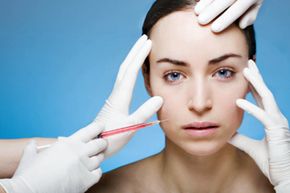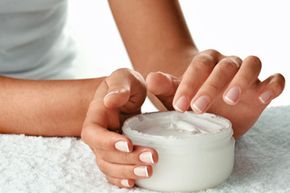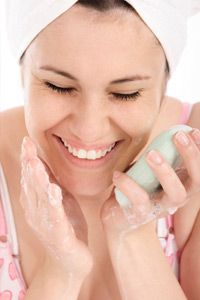Collagen is the biological equivalent of the fountain of youth where skin care is concerned. You've probably heard about it and read about it, but the real role of collagen in the body -- and in skin care -- is often misunderstood. Collagen is a protein made up of building blocks called amino acids. It constitutes about 25 percent of the protein in the human body. It can be soft and fibrous, and with some chemical embellishment, it can be used in the development of bones and teeth, too. Think of it as one of the body's basic structural resources.
Collagen constitutes a large part of the dermis, the layer of skin just below the surface you moisturize every morning. The collagen in the dermis is a bit like the padding inside a comforter that keeps the pretty fabric on the outside smooth and plush. Children have a nice padding of collagen under their skin, so even if they're slender, their faces look full, radiant and healthy. As people age, they produce less collagen. As the collagen layer becomes thinner, the skin on top starts to sag and develop lines and wrinkles. The amount of collagen loss people experience as they age can vary based on genetics and environmental factors. The basic rule here is simple: Less collagen means more and deeper wrinkles, the most recognizable signs of aging.
Advertisement
Many face creams have little positive impact on the collagen skin layer, the dermis. They provide moisture to the surface of the skin, though, which causes it to swell a little, reducing the look of wrinkles. Creams are very ingenious in the way they make use of moisture to keep the skin's surface saturated. Substances called humectants draw moisture out of the air and emollients like lanolin create a barrier holding that moisture trapped and available to the skin. These measures really aren't getting to the real problem of skin aging, though, which is loss of collagen in the dermis. They make skin look more youthful, but only temporarily. When that hard-won surface moisture begins to evaporate, the wrinkles come back.
The obvious solution is to add collagen to the dermis, but that can get complicated. The collagen molecule is large, too large to slip through the outer layer of the skin to the dermis underneath. Slathering on a palm-full of collagen won't help. There are some ways to make the skin more permeable, but skin creams containing collagen aren't quite the answer. It turns out that the most effective way to increase skin collagen, short of injecting animal collagen directly into the skin, is to coax the body to produce more collagen on its own. This is actually pretty practical. After all, the body already makes collagen. The idea here is to encourage it to make a little more and direct it over to the dermis.
On the next few pages, let's take a look at some common ingredients in skin care products that help boost collagen production and perform other skin-friendly maintenance duties that can make you look rested, younger and healthier.
Advertisement


